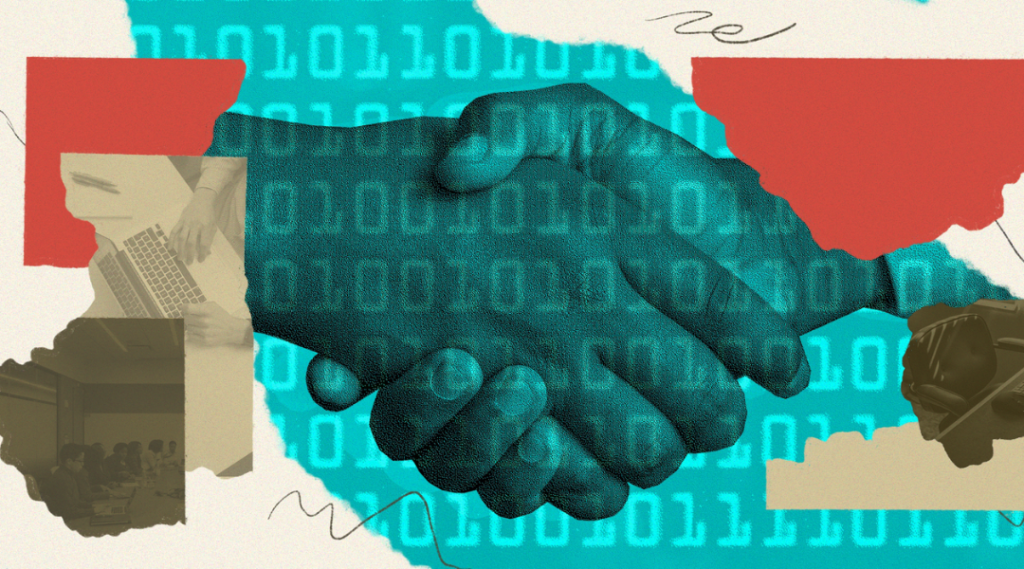Chaudhuri and Holbrook (2001) define brand trust as “the willingness of the average consumer to rely on the ability of the brand to perform its stated function”.
They also proposed that brand trust arises after consumers’ evaluation of companies’ offerings. If companies provide beliefs of safety, honesty and reliability about their brands to consumers, brand trust will be generated subsequently according to Doney & Cannon, 1997.
However, it all seems a little reactive rather than proactive, right?
What if we could engineer trust? Hack trust? Create a scenario whereby we bypass the initial scepticism and trust-building rigmarole to foster and provide genuine value?
Introducing Oxytocin:
In human beings, accumulations of Oxytocin receptors are found in the amygdala (Loup et al., 1991), a region of the Central Nervous System associated with social behaviours.
Oxytocin plays a central role in our ability to form social attachments and affiliations, ranging from parenting, relationship building both romantic & friendship and even our social memory. Additionally, Oxytocin helps to alleviate stress responses and anxiety in social interactions. In simple terms, if your Oxytocin spikes in a social setting you will feel more at ease.
Initial behavioural experiments indicate that Oxytocin also seems to be a potent modulator of social interaction behaviour and social cognition in humans (Bartz and Hollander,2006; Heinrichs and Domes, 2008).
Finally, it has also been shown that spikes in Oxytocin can be directly correlated to an individual’s willingness to place trust in others (Kosfeld et al., 2005). However, it is important to note that this is not from a general risk-taking perspective, instead, Oxytocin specifically affected the individual’s willingness to take Social Risks that centre around interpersonal interactions
So based on that premise, if we can create opportunities to create spikes in Oxytocin, we will ultimately drive a more ‘pro-social’ individual but crucially, we will create an impression of trustworthiness within the individual.
But how can we measure trust & how can we interpret the impact of Oxytocin on Trust?
The Trust Game:
In 2005, Dr Paul J. Zak carried out a study using the variant of The Trust Game, developed by Berg et al. (1995), in which participants have the opportunity to send money provided by the experimenter to another participant. This money is tripled upon receipt, and the receiving player then has the choice to return all, some, or none of this money back to the player who sent the money to them.
The carousel below breaks down the study approach:

The participants (usually about 16 at a time) were divided into half: group A and B. All the participants were told that, just for showing up, they had $10 on account to keep. A-players were then prompted by computer to see if they would like to transfer some or all of their $10 to another randomly chosen, anonymous player in group B. ( KURT WILBERDING / THE WALL STREET JOURNAL)

Any amount that A-players gave would triple in value when it hit the B-players's account. 90% of A-players (the trusters) sent some money to B-players (the recipients). (KURT WILBERDING / THE WALL STREET JOURNAL)

Each B-player was asked by computer if he or she wanted to give some of that multiplied-by-three bonus back to the giver. The question is: Could they be trusted to reciprocate? (Remember, this is anonymous, so no one would know if B-player kept all the money.) (KURT WILBERDING / THE WALL STREET JOURNAL)

About 95% of the B-players who received money sent some money back. A-players who decided to trust their partners and transfer some money ended up with an average $14, while B-players ended up with $17. (KURT WILBERDING / THE WALL STREET JOURNAL)

After drawing blood from subjects before and after the game, Mr. Zak and his colleagues found that oxytocin rises in response to trust. The more money sent by A-players, the higher the oxytocin level in B-players; the higher the oxytocin, the more money given back to A-players. (Oxytocin does not rise when money is randomly transferred by a computer into B-players accounts). (KURT WILBERDING / THE WALL STREET JOURNAL)

When players had a massage before playing the Trust Game, oxytocin levels were up 9% over controls who rested quietly. The real bonanza came with B-players who got a massage followed by a transfer of money: After that monetary sign of trust, they gave 243% more money back. (KURT WILBERDING / THE WALL STREET JOURNAL)
Our brains use Oxytocin to unconsciously assess whether a person is trustworthy. Our brain combines our memory from past encounters and the multi-sensory experience from the current encounter.
If the stranger appears to match up with people & experiences that we have had in the past, then the brain releases Oxytocin flagging the new contact as safe to trust.
In parallel, Dopamine is released from The Human Reward System associating a person we trust with pleasure, speeding up our processing the next time. Overall, Oxytocin helps us be more ‘pro-social: Compassion, Generosity, Love and so much more relies on this cycle.
Interestingly, despite Dr Paul Zak’s position as an expert on trust and Oxytocin, it doesn’t mean he is not susceptible to decision making driven by spikes in Oxytocin. In the below video he walks us through the ins & outs of Oxytocin, including a time where he fell victim to a swindle that took advantage of this better nature (08:54)
Variations of The Trust Game exist within Behavioural Science and mainstream media such as seen within Golden Balls below
Narrowing the Gap in Building Trust
So now that we have established that Oxytocin inducing experiences can drive higher levels of trust within the individual, how can brands and businesses leverage this to build trust within their consumer base?
Give Trust, Get Trust:
As demonstrated above, participants who received a higher amount of money, experienced notably higher levels of Oxytocin in their blood. This indicates that by placing trust in someone (i.e. giving them a larger sum of money), the second participant felt obliged to return a higher sum of money (95% of participants returned money).
As such, by placing a scalable level of trust in the recipient, they then felt an increasing onus to return this level of trust to the originator.
To state the obvious, a precursor for this is that you are acting in an honest and trustworthy fashion from the outset.
How could this be applied in a real-world setting? Perhaps try something like:
- Make a loan/trial with few restrictions
- Credit with minimal forms/screening
- Share a ‘secret’ with the customer to make them an insider
You can probably think of any number of ways to display trust, in doing so the customer will be far more likely to reciprocate.
Want to Learn More About Neuromarketing? Join Our Mailing List
Narrative Immersion & Empathetic Experiences:
A study was carried out to interpret the impact of empathy and narrative on Oxytocin levels and ultimately pro-social behaviours (in this case giving money to a stranger). As part of this research, a set of video clips were shown to participants centred around a father talking to the camera while his 2-year-old son, Ben, who has terminal brain cancer, plays in the background. The story has a classic dramatic arc in which the father is struggling to connect to and enjoy his son, all the while knowing that the child has only a few months to live. The clip concludes with the father finding the strength to stay emotionally close to his son “until he takes his last breath.”
A second video was included in the test to act as a control to see what the brain does when any video is being watched. This video contained the same father and son spending a day at the zoo. There was no mention of cancer or death, but the boy is bald (from his chemotherapy) and is called “miracle boy” once during the clip. This video lacks the tension induced by the typical story form but includes the same characters.
Oxytocin levels were measured before and after viewing. It was discovered that the narrative-based video containing the dramatic arc caused an increase in cortisol and oxytocin.
Tellingly, the change in oxytocin had a positive correlation with participants’ feeling of empathy for Ben and his father. Heightened empathy motivated participants to offer money to a stranger who was in the experiment. We connected a story to an emotion and then to prosocial behaviour.
The “flat” narrative of Ben and his father at the zoo did not increase oxytocin or cortisol, and participants did not report empathy for the story’s characters.
These findings suggest that emotionally engaging narratives inspire post-narrative actions—in this case, sending money to a stranger.
The reason for this, we have placed ourselves into the narrative.
Positive Physical Contact:
Despite the increasing rise of separated or virtual business, there still remains opportunities for us to conduct business in person, and these rewarding opportunities need to be leveraged where possible.
Touch primes the brain to release Oxytocin, it releases Oxytocin. However, it is important to note that this needs to be situation and context appropriate.
- Shake Hands Like a Pro: University of Iowa explored the quality of handshakes and determined that students who shook hands the best were scored higher & perceived in a more positive light for employability, extroversion and overall social skills. Did they trigger a higher level of Oxytocin within the panel? Were the panel then more receptive as a result? Applicants with ‘limp’ handshakes were scored as less employable and less outgoing.
Handshake experts recommend a firm (but not too firm) grip, eye-contact and a vigorous up and down movement. However, it is important to note that not everyone likes handshakes, take Donald Trump for example - Massage: So if a handshake is good, surely a massage is better? In the study mentioned above, the two groups who received massages shown significantly higher levels of Oxytocin which in turn resulted in Participant B giving +243% money back to a trusting stranger than participants from the control group who did not receive a massage.
Understandably, we can’t massage all our customers at the point of purchase but it is food for thought. - Hugs: Oxytocin is often referred to as the ‘cuddle hormone’ and is known to have strong effects in terms of health benefits (particularly in women) for those who hug people frequently.
Again, it may not be entirely appropriate to hug each of you customers in the hope of eliciting Oxytocin but it is a good indication of the impact of physical touch. - Shoulder Touch: A light touch on a person’s shoulder has been shown to increase the probability of a participant to choose a riskier alternative when faced with a decision, oddly though, this effect was only prevalent when females were the person touching the shoulder of the decision maker, a male touch had no effect, but female touch worked for both genders.
- Additional Touch: Additional touches beyond the handshakeis a strange space that crosses over into cultural and societal norms, we would recommend caution in this space, for example guiding someone through a doorway. If appropriate a casual touch has the potential to build trust but it remains a grey area
Digital Interaction:
How can a hug have the same impact as an Instagram like? Well, the important thing to note is that we as humans do not need to be together physically to experience genuine interaction, with the rate of technological advancement we are seeing new opportunities for interaction pop up each year.
The human brain has an incredible ability to fill in any gaps that may exist while communicating virtually, allowing our digital experiences to mimic those that happen in person.
What does that mean in practice? So essentially, we as humans will release oxytocin in response to a Facebook like just as easily as we would process a compliment.
And, in three very small-scale experiments, oxytocin research pioneer Paul J. Zak found that using Twitter and Facebook dramatically increased oxytocin levels.
Conclusion
In conclusion, while there are clearly significant benefits to the release of Oxytocin within the individual, our efforts to elicit these reactions need to be aware of context and situation.
It is not a simple equation of trigger Oxytocin and increase trust.
We as humans are highly complex, experiencing and processing a multitude of elements in parallel. So all things considered we as people need to be aware of the situation at hand, for example, I can’t imagine an account director being too keen on an Oxytocin release with an impending deadline but a keen marketing executive to pitch their new concept would be extremely receptive of a feel-good oxytocin jolt.
References:
- Empathy toward strangers triggers oxytocin release and subsequent generosity | Jorge A Barraza, Paul J Zak | https://pubmed.ncbi.nlm.nih.gov/19580564/
- How UPS’ viral story has our brains hopped-up on oxytocin and why it matters to marketers | https://businessofstory.com/how-upss-viral-story-has-our-brains-hopped-up-on-oxytocin-and-why-it-matters-to-marketers/
- This Is Your Brain on Social Media | https://everyonesocial.com/blog/this-is-your-brain-on-social-media/
- Social Networking Affects Brains Like Falling in Love | https://www.fastcompany.com/1659062/social-networking-affects-brains-falling-love
- The neuroscience of trust | https://hbr.org/2017/01/the-neuroscience-of-trust
- Why Inspiring Stories Make Us React: The Neuroscience of Narrative | https://www.ncbi.nlm.nih.gov/pmc/articles/PMC4445577/
- Oxytocin Shapes the Neural Circuitry of Trust and Trust Adaptation in Humans | https://www.researchgate.net/publication/5350929_Oxytocin_Shapes_the_Neural_Circuitry_of_Trust_and_Trust_Adaptation_in_Humans






